- Center on Health Equity & Access
- Clinical
- Health Care Cost
- Health Care Delivery
- Insurance
- Policy
- Technology
- Value-Based Care
Microinjection via the Suprachoroidal Space: A Review of a Novel Mode of Administration
ABSTRACT
Standard ocular drug delivery methods generally are safe and effective for treating diseases of the eye. However, many routes of administration carry the risk of adverse effects due to drug exposure to anterior ocular tissues. Additionally, these delivery methods may not result in high and consistent levels of a therapeutic agent delivered to target tissues for diseases affecting the posterior segment of the eye. Injection into the suprachoroidal space (SCS) represents an alternative method of ocular drug delivery to the posterior segment. SCS injection facilitates targeted distribution to affected chorioretinal tissues for potential efficacy benefits, compartmentalization away from unaffected anterior segment tissues for potential safety benefits, and a high degree of bioavailability. Furthermore, the SCS may serve as a drug depot for long-acting drug delivery of small-molecule suspensions. Until recently, drug delivery to the SCS could be achieved only in the operating room setting with anesthetic immobilization of the eye and surgical dissection through the sclera. A novel microneedle device, the SCS Microinjector® (Clearside Biomedical, Inc) was developed to permit physicians to administer therapies safely and reliably into the SCS in the office setting. Successful use of SCS injection has been demonstrated with triamcinolone acetonide injectable suspension (Xipere®, Bausch + Lomb), a novel formulation optimized for use with the SCS Microinjector®. FDA approval of this combination drug and device for the treatment of macular edema associated with uveitis (UME) was based on outcomes from the phase 3 PEACHTREE study (NCT02595398); other important studies included its long-term observational extension (MAGNOLIA; NCT02952001) and an open-label safety study (AZALEA; NCT03097315). The SCS Microinjector® together with triamcinolone acetonide injectable suspension for use in the SCS presents an opportunity for safe and effective drug delivery for the treatment of UME and, potentially, for broader use with alternate medications to treat other ocular diseases that impact chorioretinal tissues (eg, age-related macular degeneration, diabetic retinopathy, choroidal melanoma).
Am J Manag Care. 2022;28:S243-S252. https://doi.org/10.37765/ajmc.2022.89270
For author information and disclosures, see end of text.
Introduction
A novel target for administration of ocular therapy—the suprachoroidal space (SCS)—and the advantages and utility of microneedle drug injection to access this area have attracted increased interest from ophthalmologists. Standard ocular drug delivery methods may involve systemic treatment, topical application, and delivery adjacent to the eye (periocular) or into the vitreous humor.1,2 Systemic therapy may be associated with adverse effects (AEs) due to systemic drug exposure, whereas local therapy can be limited by drug exposure to unaffected ocular tissues and by variable or low concentrations of the therapy delivered to target tissues due to the eye’s anatomy.1-6 For diseases affecting the posterior tissues of the eye, SCS administration offers compartmentalization of therapies away from anterior tissues and the potential for long-acting delivery to target tissues.7,8
One disease that can affect posterior tissues and that is associated with considerable visual impairment is uveitis, which is characterized by inflammation of the uveal tract (ie, iris, ciliary body, and choroid) and adjacent structures.1,3,9 Uveitis can result from either infectious or noninfectious (eg, autoimmune) processes.1 The results of a claims-based analysis of data from the US OptumHealth Reporting and Insights database found that among patients with at least 2 medical claims related to a diagnosis of uveitis in 2012, 91% (4827) of 5299 uveitis cases were classified as noninfectious uveitis (NIU).10 The investigators also estimated that in 2015, the prevalence of NIU in the United States was approximately 121 patients/100,000 adults. However, these results may not be generalizable to the entire US population, as data analyzed were commercial insurance claims only.10
The most common complication of NIU and the primary condition associated with vision loss in uveitis is macular edema (ME), a central accumulation of extracellular fluid in the retina.9,11 Although prevalence varies according to the underlying cause of inflammation, ME generally affects 8% to 30% of patients with uveitis.9,12,13 Uveitis associated with ME (UME) is the first ocular condition for which an SCS injection-based therapy has been approved.
This article summarizes standard techniques for ocular delivery with a focus on the delivery of corticosteroids for NIU and UME; it then introduces the SCS as a delivery option for therapies intended to treat the back of the eye. Also included is a brief presentation of clinical data on SCS-TA, a triamcinolone acetonide (TA) injectable suspension (Xipere®, Bausch + Lomb) delivered via the SCS Microinjector® (Clearside Biomedical, Inc).14 SCS-TA is the first FDA-approved treatment to utilize the SCS and is indicated for the treatment of UME.14
Techniques for Ocular Drug Delivery
Numerous methods of drug delivery have been developed for treating diseases of the eye, and each has benefits and disadvantages. Standard methods include systemic delivery (eg, oral, intravenous, and subcutaneous routes) as well as local drug delivery methods (eg, topical eye drops, periocular or intravitreal [IVT] injections, and IVT implants) (Figure 1).2 Systemic delivery of drugs for ocular conditions can result in systemic AEs, such as gastrointestinal (GI) issues.1,2 Furthermore, local delivery methods may be limited by the occurrence of AEs associated with drug exposure to unaffected tissue and, in some cases, by the inability of drugs to penetrate the cornea or sclera or into the posterior segment when delivered via a topical or periocular route.1-6 More recently, SCS injection was introduced as an alternative method of ocular drug administration.1,14
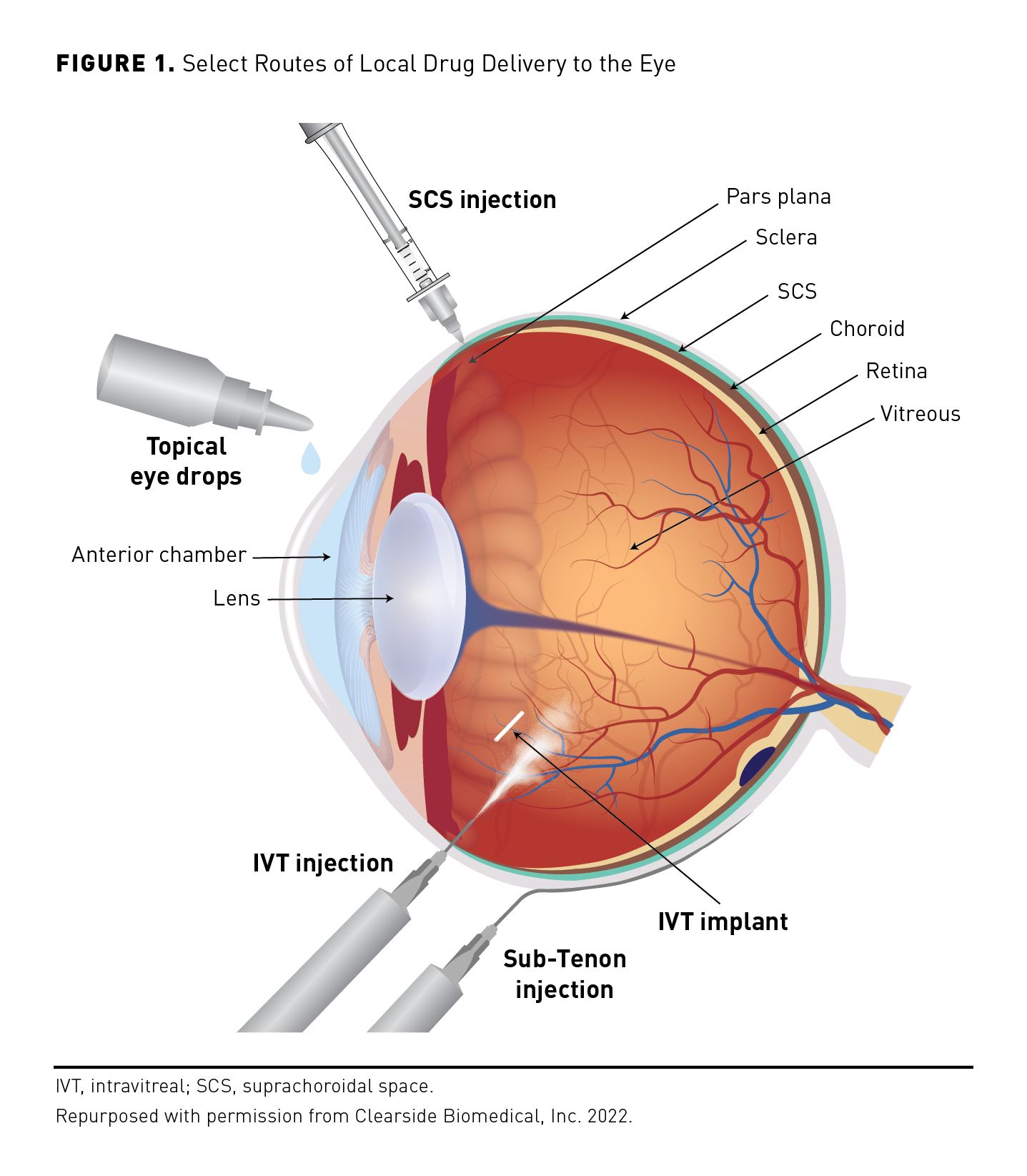
Systemic and Topical Therapies in NIU and UME
Systemic therapies—including steroidal and nonsteroidal anti-inflammatory drugs and biologic and nonbiologic immunomodulatory agents—are effective for treating UME but are often recommended in cases of bilateral disease or cases refractory to local therapy due to the potential for systemic complications.12 Even at low doses, but particularly when administered over the long term, systemic corticosteroid treatment for NIU and UME may be associated with AEs such as infection and GI disturbances; similarly, systemic immunomodulatory agents and nonsteroidal anti-inflammatory drugs confer the risk of GI issues when used alone or in combination with steroids.2,9,12 Topical eye drops are a mainstay of local ocular corticosteroid therapy in NIU; however, their efficacy can be limited by an inability to penetrate to posterior eye structures, which results in poor bioavailability for posterior conditions.2,4 Because eye drops may require frequent reapplication due to a high clearance rate and drug dilution at the ocular surface, patients may show poor adherence to treatment.1,2,15 Further, corticosteroid eye drops carry the risk of elevated intraocular pressure (IOP) and cataract development due to anterior segment drug exposure.2,4
Injection and Implantation Techniques in NIU and UME
Another method for local drug delivery, periocular sub-Tenon injection of corticosteroids is administered by cannula or needle into the superior temporal or inferior temporal quadrant.2 However, sub-Tenon injection of corticosteroid medications requires permeation through the sclera; it can be associated with variable levels of corticosteroid delivered to the posterior segment, exacerbation of cataracts, and elevation of IOP.2,6,16 The results of the multicenter, randomized clinical trial (RCT) in UME (POINT; NCT02374060) indicated that sub-Tenon injection of TA—a corticosteroid commonly used to treat UME1-3,16—was associated with inferior central subfield thickness (CST) reduction and visual acuity (VA) improvement when compared with IVT injection of TA and IVT implant of dexamethasone.2,17 Thus, use of alternative injection techniques may be preferred, particularly in treating UME.
Drug delivery into the vitreous via injection or implantation is the most common and direct method for administering therapeutic doses of a drug into the posterior segment of the eye, and both can be accomplished in an office setting.5,15 IVT delivery of corticosteroids is effective for treating UME in the posterior segment, characteristically in patients with moderate to severe unilateral UME or for whom immunomodulating treatments fail or are not tolerated.1,9,12 It is also used as an interim treatment for UME in patients who later receive long-term immunomodulating therapy.1 IVT treatment via implantation of sustained-release technologies allows for delivery of a controlled drug dose to a desired location over time; this reduces the need for repeated treatments and potentially reduces the risks of infection and retinal detachment.5 Possible complications inherent to IVT delivery include increased IOP, endophthalmitis, retinal detachment, and cataract development that partially arise from corticosteroid exposure in the anterior chamber.3,5,15
The MUST RCT (NCT00132691) enrolled 255 participants (479 eyes) with NIU between December 2005 and December 2008 and compared efficacy and safety results in patients receiving either the 0.59 mg fluocinolone acetonide (FA) intraocular implant (Retisert®, Bausch + Lomb) or systemic corticosteroid therapy supplemented with further immunosuppression, when indicated.18,19 The FA intraocular implant releases the drug into the intravitreal space over approximately 30 months.19 The outcomes of this trial illustrated the risks and benefits of an IVT sustained-release corticosteroid implant in treating NIU vs systemic therapy.18 After 24 months, significantly more eyes treated with the IVT FA implant experienced control of uveitic inflammation vs eyes from participants treated with systemic steroids (P = .001). Both treatments were associated with a decreased incidence of ME; use of the FA implant conferred a significantly greater likelihood of reducing ME after 6 months than did systemic corticosteroid therapy (P = .002), although the difference was no longer significant by 24 months (P = .071). However, patients who received the FA implant were over 4 times more likely to experience an IOP elevation of at least 10 mm Hg or an absolute IOP of at least 30 mm Hg or to require medical or surgical intervention for elevated IOP (all P < .0001).18 In a 7-year extended follow-up of participants in the MUST study, those randomly assigned to receive systemic therapy had better visual acuity than did those randomly assigned to receive IVT FA implants; however, this interpretation is limited by loss of patients to follow-up and to inconsistent reimplantation in the FA implant group following depletion of implants.20
SCS Administration: An Innovative Drug Delivery Technique
Administration of medication to the SCS, which is located between the choroid and the sclera (Figure 2), offers several advantages over other methods of local ocular drug delivery by avoiding physical barriers (eg, the sclera).4,6,21 Under normal conditions, the SCS is in a largely collapsed state due both to IOP and to fibers attaching the sclera to the choroid; however, it can expand and collapse with fluid entrance and egress.4,15 Because of its location adjacent to the choroid and, more generally, the posterior segment, the SCS offers a novel target for drug delivery, with the potential for broad distribution and high bioavailability of therapeutic agents and relatively easy access to posterior target tissues.4,21 Drugs injected into the SCS spread circumferentially; when injected into the pars plana region, they expand the SCS and quickly flow posteriorly due to the differential between the IOP and the posterior SCS pressure.4,21-24
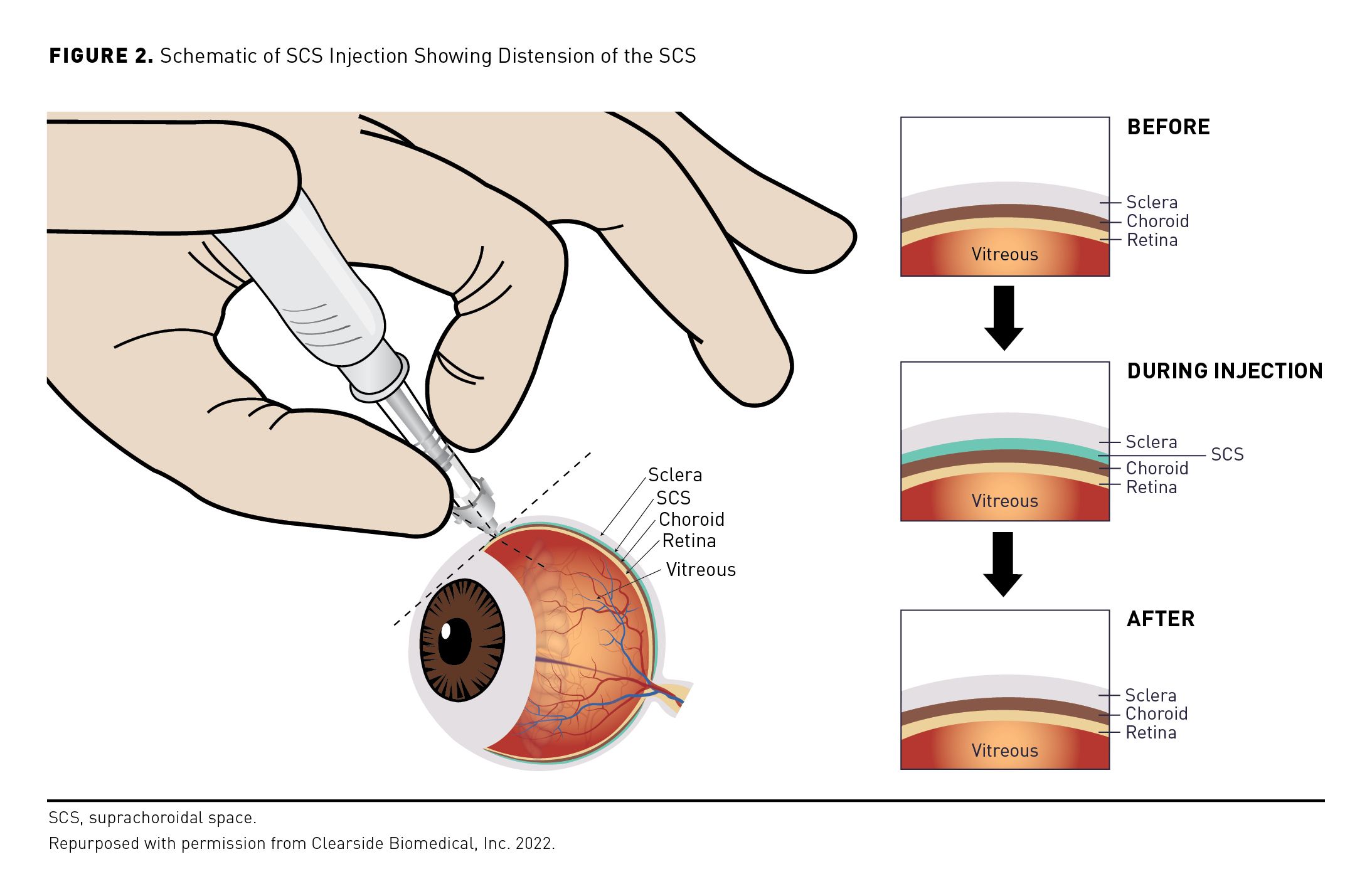
The sclera adheres tightly to the ciliary body at the scleral spur, limiting anterior distribution of injectate.22 In animal models, drugs injected into the SCS were undetectable in the aqueous humor and had negligible dissemination into the vitreous as compared with those given via IVT injection.7,8 Because of this compartmentalization of administered drugs away from the anterior segment of the eye, SCS delivery may decrease the risk of some AEs associated with drug exposure to the anterior chamber, such as elevations in IOP and development or progression of cataracts associated with corticosteroid use.4,15
Until recently, therapeutic access to the SCS generally has required surgical dissection through the sclera in the operating room with the target eye anesthetized and immobilized.4 This changed with the development of a proprietary SCS microneedle delivery system, the SCS Microinjector®, which consists of a piston syringe and 2 microneedles (900 µm and 1100 µm; different lengths are provided to account for patient variability in scleral thickness15) (Figures 2 and 3).14 Administration via the SCS Microinjector® is a 3-step process, beginning with insertion of a 900-µm microneedle into the sclera at an angle perpendicular to the eye and 4 mm to 4.5 mm posterior to the limbus.14,22 The next step is application of gentle force to allow the needle hub to depress the ocular surface and form a seal between the needle hub and conjunctiva; this ensures that the needle opening can reach the SCS and limits reflux during the injection. The third step is slow injection into the SCS over 5 to 10 seconds, maintaining a perpendicular position and compression on the conjunctiva and then keeping the needle hub in place for 3 to 5 seconds after injection.14,22 If resistance occurs, injection at a new site is recommended; if resistance continues, a switch to the provided 1100-µm microneedle may allow for penetration into the SCS.14 The SCS Microinjector® provides more reliable access to the SCS than does a hypodermic needle, as hypodermic needle use involves a steep tactile learning curve to feel when the sclera has been penetrated and to avoid accidental IVT injection.4,22 Use of the SCS Microinjector® also is less invasive than is cannulation, as it does not require an incision with scleral dissection.22 In addition, SCS injection can be performed in the outpatient setting using local anesthesia.4,22
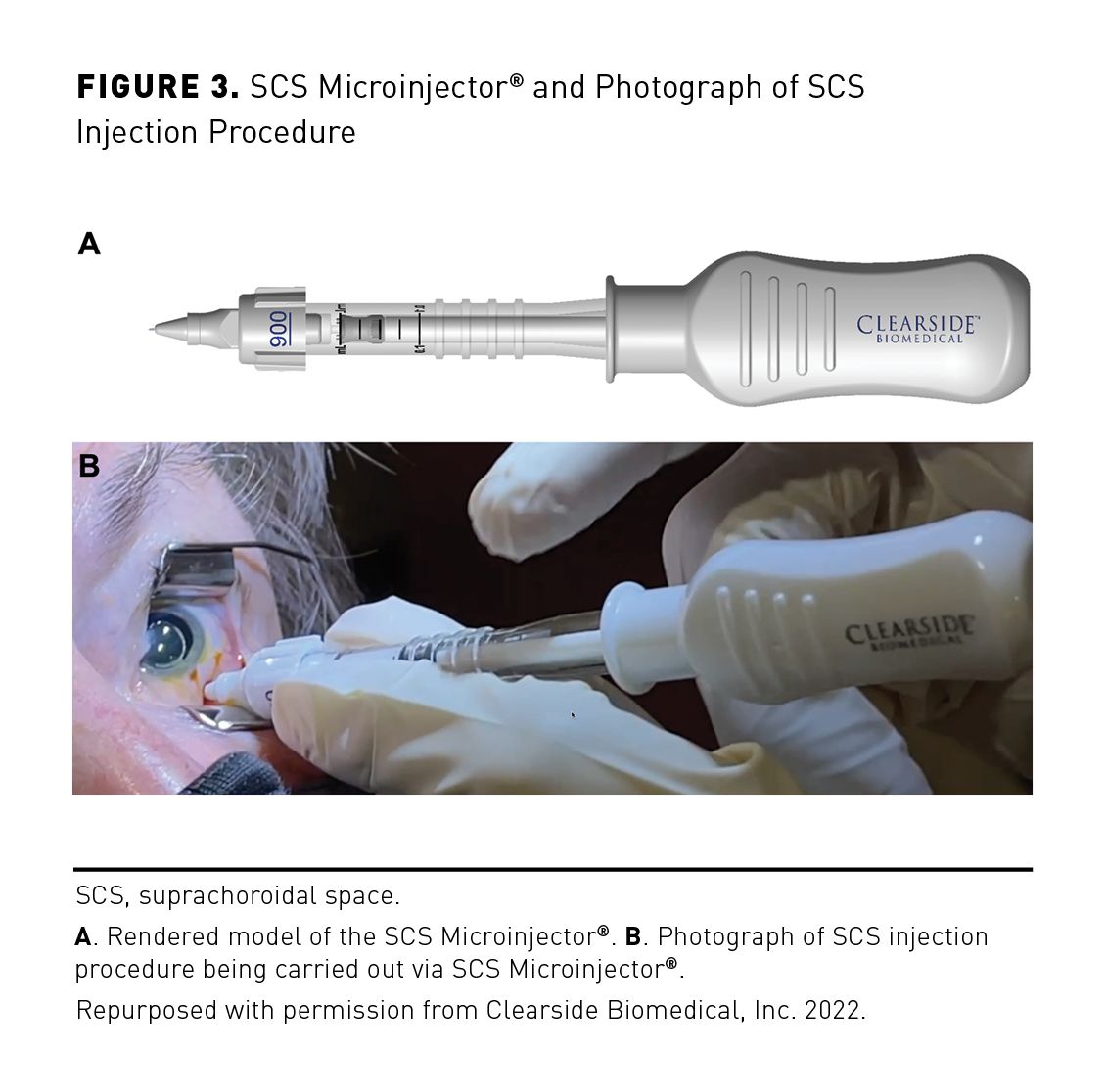
Scleral Thickness and Needle Length
A loss of resistance is felt when the microneedle reaches the SCS due to the density of the collagen matrix that composes the sclera.22 Drug injection into the dense sclera is not possible; if the microneedle used is not long enough, the injection cannot proceed.22 Although thickness of the sclera can vary from anterior to posterior, thickness of the sclera at the pars plana site of injection varies only minimally between individuals and between quadrants of the eye.22,25 The microneedle in the SCS Microinjector® is designed to penetrate both the conjunctiva and sclera; the microneedle lengths were selected to make piercing of the choroid or retina unlikely while addressing the known minimal variability in scleral thickness.4,22
Two post hoc analyses examined patient and clinical characteristics associated with SCS administration of SCS-TA via the 900-µm microneedle (Table 1).26,27 In a post hoc study of data from 6 clinical trials involving 3 different ocular disorders affecting the posterior segment (NIU, diabetic ME [DME], and retinal vein occlusion [RVO]), a 900-µm microneedle was used to administer SCS-TA in 70.9% of the procedures, and the remaining procedures were carried out with the 1100-µm microneedle.26 Statistically significant correlations were found between needle length and patient gender (P = .006) and needle length and quadrant of administration (P = .0005) (Figure 4), although further study is needed to determine whether these correlations may be used to guide preselection of needle length.26 There was no significant difference in needle length used among participants with NIU vs other disorders (P = .504).26
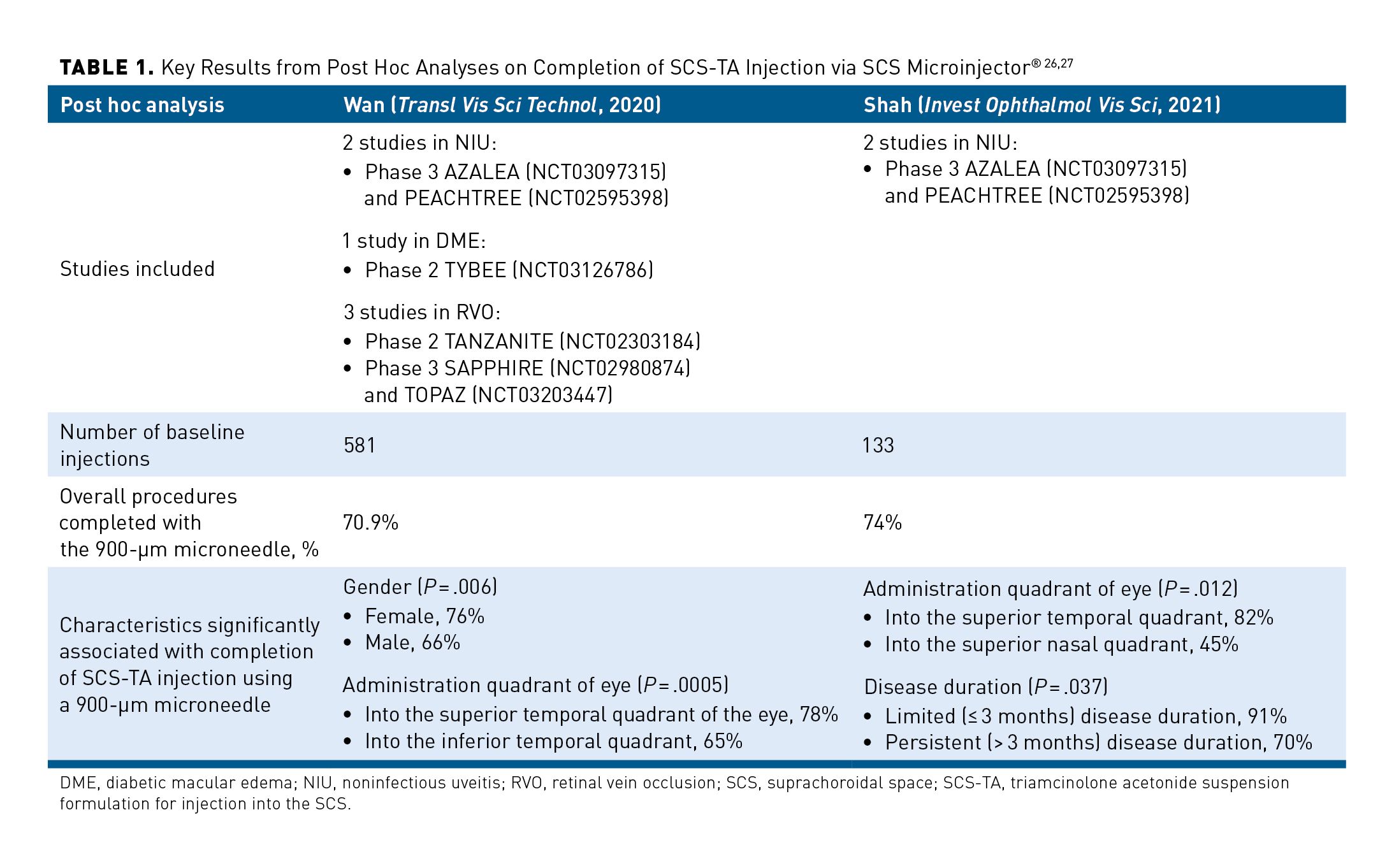
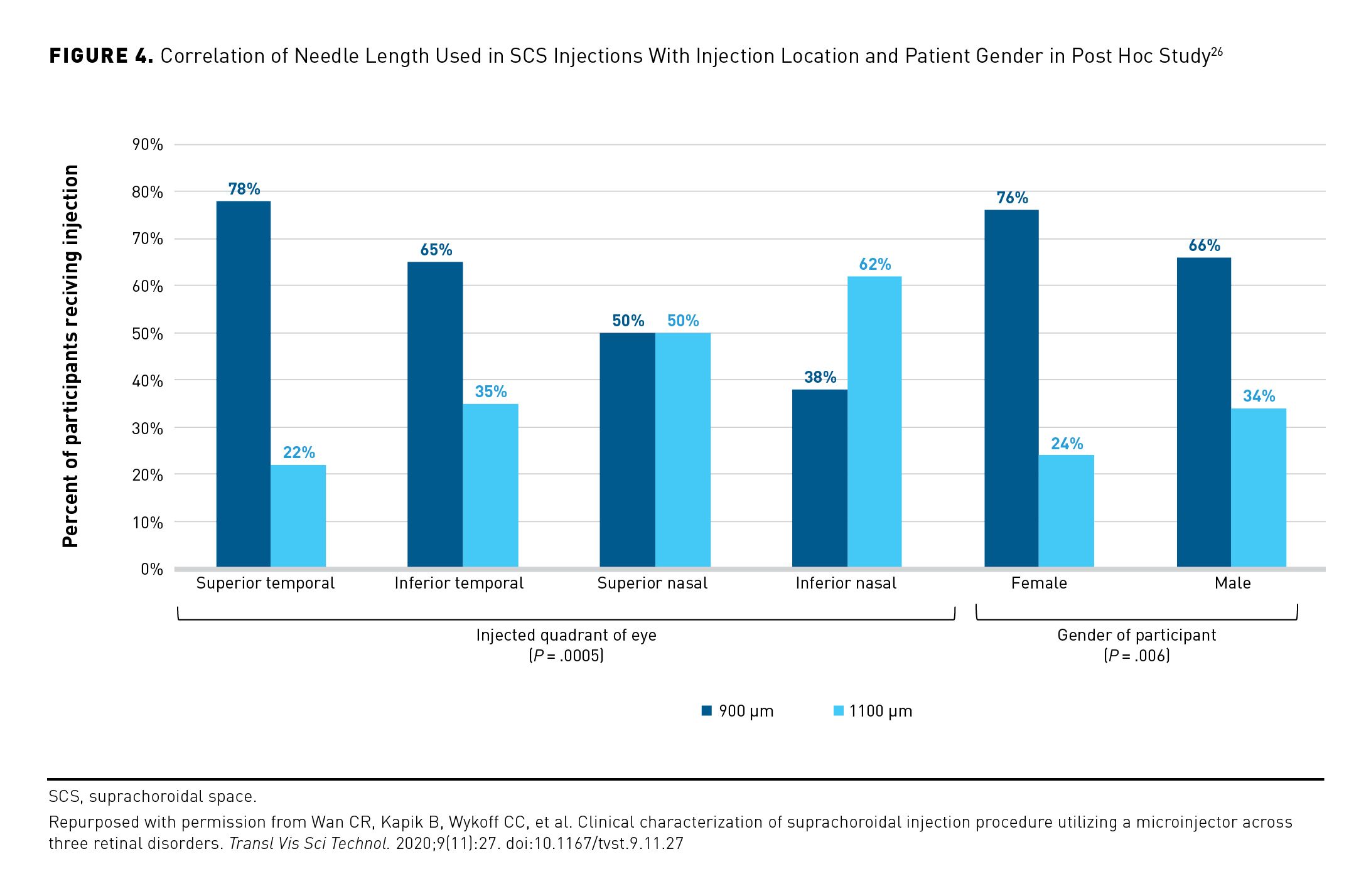
A separate post hoc analysis of SCS Microinjector® needle length used in 2 clinical trials of patients with NIU was presented at the 2021 Association for Research in Vision and Ophthalmology Annual Meeting (ARVO 2021).27 Treatment was completed with the 900-µm microneedle in 74% of injections, and the 1100-µm microneedle was used for the remaining injections. No correlation was found between needle length and gender, although significant relationships with needle length were observed for injection quadrant and disease duration (P = .012 and P = .037, respectively).27 A modest inverse correlation between age and needle length also was observed.27 The 2 post hoc analyses on needle length usage demonstrated that the 900-µm microneedle can be used for the majority of SCS-TA injections. However, it is not yet clear whether statistical differences observed in either of the post hoc analyses are sufficiently meaningful to guide preselection of needle length.
Preclinical Studies of SCS Administration
For small-molecule suspensions, drug particle size and the relative insolubility of molecules are important factors driving drug durability following SCS administration.22 The results from 1 preclinical study found that drug particles ranging from the size of gene therapy viral vectors to small-molecule suspensions (eg, 10 nm to 10 µm) remained primarily in the SCS and choroid for a period of months.28 The physiologic upper limit of pore size in the fenestrated choriocapillaris is estimated to be between 6 nm and 12 nm, which likely limits transcapillary passage of particles.29
Animal Model Studies of SCS Injection
In porcine and canine ex vivo models, fluid volume of up to 1 mL injected via cannulation into the SCS resulted in rapid local SCS expansion before flowing posteriorly.21 The potential for a high level of bioavailability after SCS injection extends beyond the choroid to the retinal pigment epithelium (RPE) and, ultimately, to the retina.4 In a rabbit model, SCS injection of a solution containing micronized axitinib compounded with a wetting agent, a tonicity agent, and a viscosity-enhancing agent resulted in much greater drug exposure in the retina, choroid, and posterior sclera and substantially decreased drug exposure in the vitreous humor vs IVT injection.7 After SCS injection, axitinib levels in the plasma and aqueous humor were undetectable. The utility of the SCS as a location for drug administration was further confirmed by the observation that a single SCS injection produced sustained and high levels of axitinib in the RPE-choroid-sclera (RCS) and retina. After 6 months, in a separate rabbit toxicology study, mean axitinib levels in the RCS and in the retina were 3 to 5 log orders higher than the in-vitro concentration of an agent needed to inhibit VEGF receptor 2 by 50%, further supporting the potential for long-acting drug delivery to posterior segment tissues through SCS injection.7
Additionally, a series of studies in rabbits compared drug distribution following IVT and SCS injection of the TA injectable suspension formulation Triesence (TRI; FDA approved for uveitis and several other ocular diseases) and following SCS injection of 2 different TA formulations, including TRI and an investigational prototype of a TA injectable suspension for use in the SCS (X-TA).8,30
In the first of these 2 studies, 50 rabbits received TRI as bilateral IVT injections or as bilateral SCS injections to compare drug concentrations in ocular tissues and plasma after drug delivery. At day 91 (end of study), the levels of TA in the RCS were 12-fold higher with SCS injection than with IVT injection. Further, SCS injection resulted in lower levels of TA in the vitreous and aqueous humors, iris/ciliary body, and lens compared with IVT injection over the duration of the study.8
In the second study, 20 rabbits were randomly assigned to receive bilateral SCS injections using either TRI or X-TA with the SCS Microinjector®. No TA was detected in the aqueous humor throughout the 91-day study; on day 15, minimal levels of TA were observed in the vitreous humor of eyes receiving SCS injection of either formulation, whereas comparable levels of TA were detected in the RCS for X-TA vs TRI throughout the study.8
Results from these 2 studies showed that SCS injection resulted in durable TA levels in posterior tissues over the course of 3 months. Furthermore, injection into the SCS resulted in TA sequestration away from anterior tissues. Thus, these results support a potentially lower risk of IOP elevation and cataract development associated with anterior tissue exposure to TA.8
Simulated SCS Injection
The previously mentioned X-TA suspension prototype is a proprietary formulation of TA designed for SCS microinjection; it contains surfactants chosen to improve wetting, reduce the coefficient of friction, and minimize foaming and the formation of microbubbles.8
To examine injectability of this TA formulation specifically designed for SCS delivery, investigators assessed the glide force—the required pressure applied to the SCS Microinjector® plunger to expel the formulation—of TRI vs X-TA using the SCS Microinjector® in a series of 7-second simulated microinjection procedures.8 Injections of air and water were included as controls. Glide force was significantly higher with the TRI formulation vs X-TA (P < .001), and TRI was associated with greater variability in glide force than was X-TA (Figure 5).8 The glide force profile for X-TA was notably closer to the glide force for injections of air and of water than was that of TRI (0.73 N vs 0.19 N, 0.23 N, and 1.31 N, respectively). Less force was needed to overcome the syringe-plunger’s resistance to flow when injecting X-TA vs TRI; for the physician, this may provide a more distinct tactile signal that the microneedle tip has entered the SCS or that a change to the 1100-µm microneedle is needed. Compared with that of TRI, the particle size of X-TA is smaller; this difference could contribute to reduced variability and lower necessary glide force when injected through the 30-gauge needle of the SCS Microinjector®.8,14,31 Consequently, the use of a TA formulation specifically designed for SCS injection may help to achieve controlled and consistent delivery due to lower necessary injection force and less variability in applied pressure as a result of expedient choice and tightly controlled particle size distribution of the drug.8
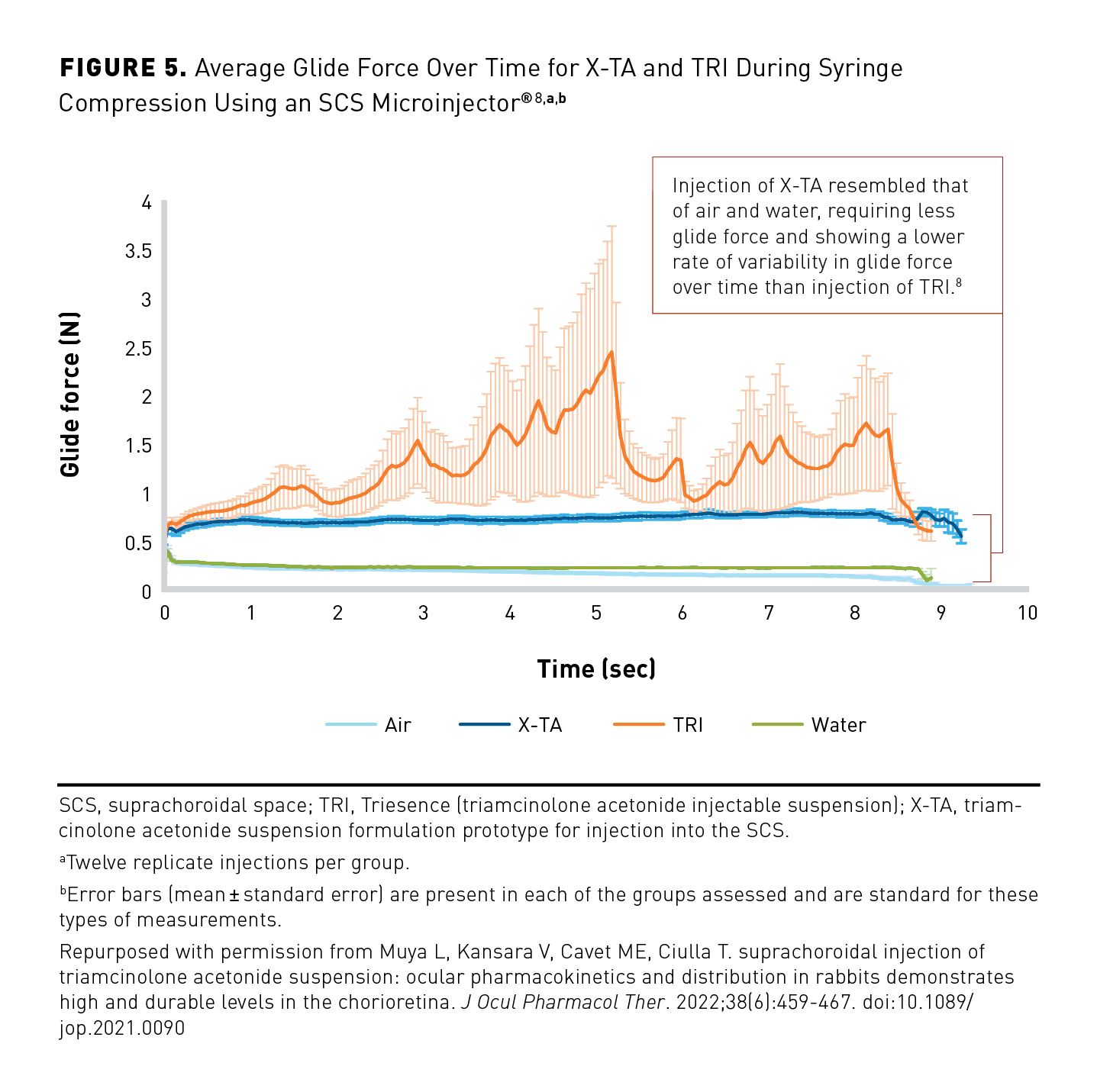
Clinical Trials Supporting SCS Administration of SCS-TA in NIU and UME
The anti-inflammatory activity of TA is well known, and the drug has been extensively studied for the treatment of NIU and UME via periocular or IVT injection.1-3,16,30 However, SCS-TA offers potential advantages in terms safety, efficacy, and ease of injection.8,14,32 FDA approval of SCS-TA to treat UME via SCS administration was based on the results of the phase 3 PEACHTREE trial (NCT02595398) (Table 2).14,32-35
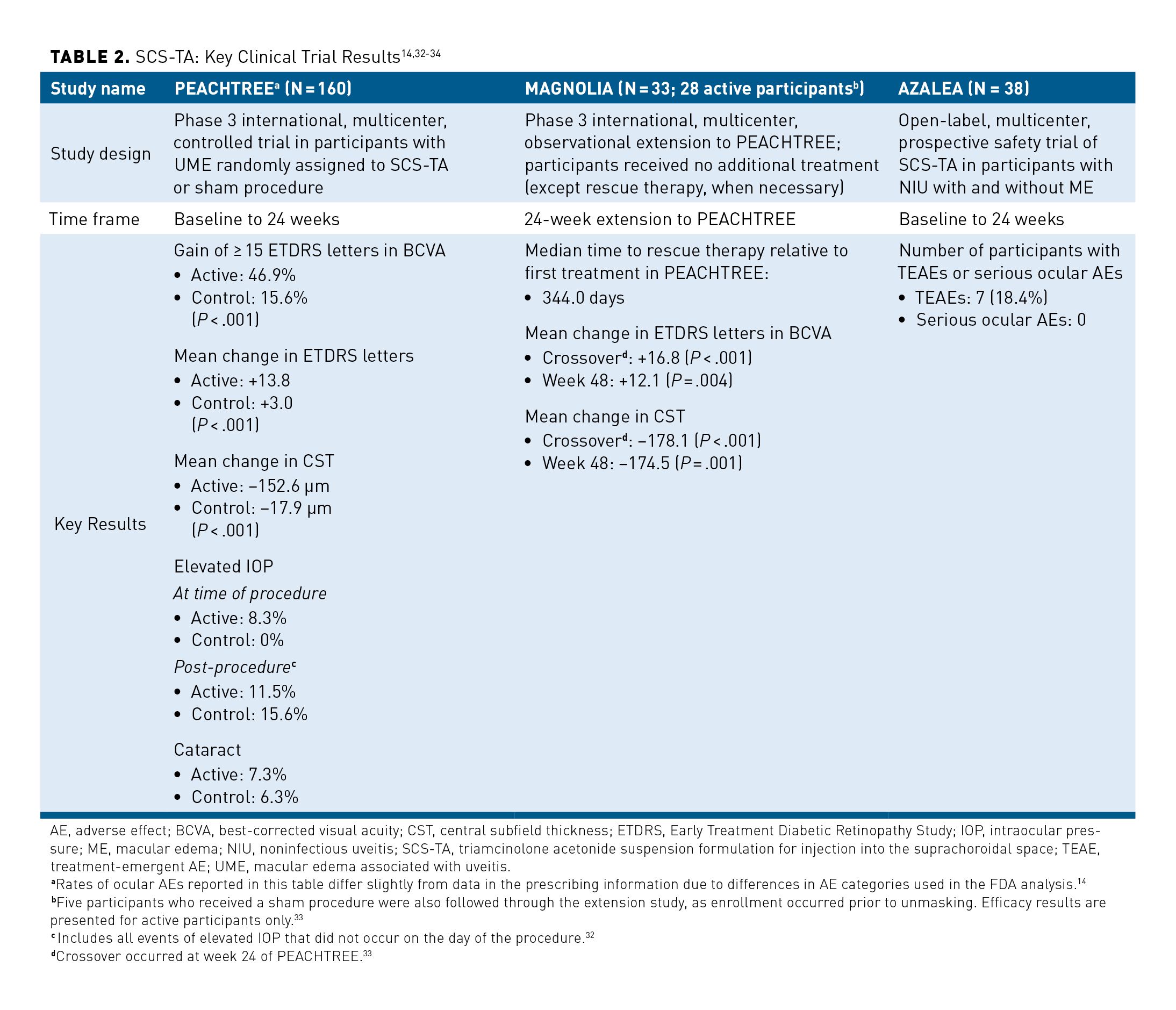
PEACHTREE was a 24-week, international, multicenter study conducted between November 2015 and January 2018 in 160 participants with UME who were randomly assigned 3:2 to receive a single injection of SCS-TA via SCS Microinjector® (n = 96) or a sham SCS injection procedure (control; n = 64) at day 0 and again at week 12; follow-up visits occurred every 4 weeks for the duration of the trial, and efficacy end points were assessed at 24 weeks.32 Compared with participants in the control arm, significantly more participants in the SCS-TA arm gained at least 15 Early Treatment Diabetic Retinopathy Study (ETDRS) letters (≥ 3 lines) in best-corrected VA (BCVA) (P < .001). In addition, participants in the SCS-TA arm achieved a significantly greater mean reduction in CST compared with those in the control arm (P < .001). Although more participants in the SCS-TA arm than in the control arm experienced elevated IOP at the time of procedure, fewer experienced elevated IOP related to corticosteroid use (ie, events occurring after the day of the procedure). All participants in the control arm who experienced AEs of elevated IOP had received rescue therapy with local corticosteroids. Finally, cataract AE rates were similar between the SCS-TA group and the control group.32
A post hoc analysis of outcomes from the PEACHTREE trial compared the 83 participants in the SCS-TA arm (86.5%) who completed the study without requiring rescue therapy with the 46 participants in the control arm (71.9%) who required rescue therapy (of whom 37 [80.4%] received IVT injection or periocular corticosteroids).36 Unrescued SCS-TA participants had a lower incidence of elevated IOP (≥ 30 mm Hg) than did rescued control participants (4.9% vs 10.9%, respectively); further, the incidence of IOP-lowering medication use was lower in unrescued SCS-TA participants than in rescued control participants (7.2% vs 13.0%, respectively).36
The MAGNOLIA study (NCT02952001) was an international, multicenter, observational extension study of 33 participants who successfully completed the PEACHTREE study without the use of rescue medications (Table 2).14,32-34 Relative to the first dose of study drug in PEACHTREE, patients in the SCS-TA arm had a median time to rescue therapy of 344.0 days.33 In addition, patients in the SCS-TA arm not receiving rescue therapy showed a significant gain in mean BCVA letters and a significant reduction in mean CST from the PEACHTREE baseline to week 24 of MAGNOLIA (48 weeks from PEACHTREE baseline; P = .004 and P = .001, respectively).33
An additional post hoc analysis used pooled data from the 33 participants in MAGNOLIA and the 127 participants from PEACHTREE who were not enrolled in MAGNOLIA to determine the probability of rescue medication use over the entire 48-week period.33 The median time to rescue relative to the last dose of study drug was significantly longer among the participants treated with SCS-TA than among the participants in the control arm (257.0 vs 55.5 days, respectively), and the time to rescue distributions were significantly different (P < .001).33
Finally, the open-label, prospective, multicenter AZALEA safety trial (NCT03097315) evaluated rates of serious AEs (SAEs) and treatment-emergent AEs (TEAEs) in 38 participants with NIU (20 participants with ME; 18 participants without ME) who were treated with SCS-TA given via SCS Microinjector® (Table 2).14,32-34
Similar to dosing in PEACHTREE, AZALEA participants received a dose of SCS-TA at baseline and at 12 weeks, with follow-up every 4 weeks to 24 weeks.34 Mean IOP was 13.3 mm Hg at baseline and 15.2 mm Hg at week 24 in the study eye. Six participants (15.8%) had an IOP elevation of more than 10 mm Hg compared with baseline in the study eye, and 2 participants (5.3%) had an IOP of more than 30 mm Hg. Cataract formation AEs were reported in 4 study eyes (10.5%); 1 of which was deemed related to treatment. Seven participants experienced a TEAE considered to be related to the study drug by an investigator, and no SAEs involving the study eye were reported.34
Post Hoc Analysis on the Safety of SCS Injection of SCS-TA in Different Ocular Diseases
A post hoc analysis presented at ARVO 2021 used pooled data from 8 clinical trials of SCS-TA in NIU, DME, or RVO and compared the safety of SCS-TA monotherapy via the SCS Microinjector® (n = 166) vs a combination of SCS-TA injection plus IVT anti-VEGF injection (n = 460) vs sham SCS injection plus IVT anti-VEGF injection (control; n = 449).37
Of the 626 participants receiving at least 1 SCS-TA injection, 3 participants (all of whom received multiple injections) experienced ocular SAEs of interest (1 retinal detachment in a quadrant different from and 8 weeks after SC injection, and 2 cases of reduced vision ≥ 1 week after SC injection), although none of the events were deemed related to treatment.37 There were no SAEs involving retinal tear without detachment, lens injury, suprachoroidal hemorrhage, endophthalmitis, or central retinal artery occlusion in patients receiving SCS-TA monotherapy or combination therapy.37 Additionally, the AE rates of eye pain experienced by patients with NIU, RVO, or DME who received SCS injections of SCS-TA were similar to those reported in registration trials of IVT anti-VEGF agents approved for ocular diseases.37-39 These results support SCS injection of SCS-TA as offering acceptable safety and incidence of eye pain compared with IVT injection.37
Discussion
The development of a microinjector device optimized for drug delivery to the SCS addresses an unmet need in the treatment of ophthalmic diseases affecting the posterior segment of the eye. Other delivery methods have demonstrated efficacy in treating ocular diseases such as NIU and UME, but each of these approaches has been associated with considerable risk of AEs, and efficacy may be affected by limitations inherent to the eye’s anatomy.1-6 Such limitations are largely a consequence of the challenges associated with the eye’s anatomy and the difficulty both of delivering the appropriate levels of drug to the correct target areas and of avoiding distribution to locations where it might induce undesirable effects.5,6,15
In this context, the SCS offers an ideal route for drug delivery to the eye, access to posterior target tissues, and optimal drug distribution and bioavailability.4,21 Moreover, the structure of the SCS enables a degree of drug sequestration away from the iris/ciliary body, lens, and aqueous humor, thereby limiting drug exposure to anterior tissues.7,8,22 Previous methods of accessing the SCS often required an operating room setting with immobilization of patient’s eye under anesthesia and surgical dissection through the sclera.4 The SCS Microinjector® was designed specifically to access the SCS safely and easily using only local anesthesia.4,14
Results from the PEACHTREE study, along with those from the MAGNOLIA and AZALEA studies, offer compelling evidence for the safety of SCS injection with the SCS Microinjector® and the effectiveness of SCS-TA delivered via the SCS Microinjector® to treat UME.32-34 The broader implication of improvements in BCVA among participants with UME in PEACHTREE are illustrated by results of an analysis conducted by the MUST Trial Research Group on the relationship between improvements in VA and visual function outcomes.40 A 1-line improved BCVA score (equivalent to the difference between 20/20 and 20/25 or 20/160 and 20/200 scores on the Snellen scale) was associated with significantly higher scores for general vision, driving, color and peripheral vision, and vision-specific social functioning, mental health, and dependency on the National Eye Institute Visual Function Questionnaire (all P < .0001).40 In the PEACHTREE study, 46.9% of participants treated with SCS-TA experienced a BCVA improvement of at least 3 lines.32
SCS delivery of various drug formulations, including small-molecule suspensions and viral-vector therapies, has been evaluated in clinical trials to treat several disease states.15 Therapeutic agents currently under investigation for SCS delivery include the tyrosine kinase inhibitor axitinib to treat neovascular age-related macular degeneration (nAMD; NCT04626128), a viral-vector gene therapy to treat nAMD (NCT04514653) and diabetic retinopathy (NCT04567550), and a virus-like drug conjugate to treat primary indeterminate lesions and small choroidal melanoma (NCT04417530).15,41-44
Conclusions
SCS-TA is the first drug to be FDA-approved for SCS administration. The combination of SCS-TA formulation and SCS Microinjector® represents a meaningful addition to the therapeutic landscape for treatment of UME. Additionally, the SCS Microinjector® provides new opportunities for treating ocular diseases with an SCS drug delivery procedure in the office-based setting, offering the potential for broad use across several ocular diseases with delivery of different drugs.
For more information about the efficacy and safety of SCS-TA, click here.
Authorship affiliation: Clearside Biomedical (TC); Indiana University School of Medicine (TC); University of Nebraska Medical Center (SY)
Funding source: This work is supported by Bausch + Lomb.
Author disclosure: Dr Ciulla is employed by and owns stock in Clearside Biomedical, which performs research and development using its SCS Microinjector®. Dr Yeh reports serving on a consultancy or paid advisory board for Bausch + Lomb, Adverum Biotechnologies, and REGENXBIO.
Authorship information: Concept and design (TC and SY); acquisition of data (SY); analysis and interpretation of data (SY); critical revision of the manuscript for important intellectual content (TC and SY); supervision (TC).
Address correspondence to: Thomas Ciulla, MD, MBA. Clearside Biomedical, 900 North Point Pkwy, #200, Alpharetta, GA, 30005. Thomas.ciulla@clearsidebio.com
REFERENCES
- Valdes LM, Sobrin L. Uveitis therapy: the corticosteroid options. Drugs. 2020;80(8):765-773. doi:10.1007/s40265-020-01314-y
- Conrady CD, Yeh S. A review of ocular drug delivery platforms and drugs for infectious and noninfectious uveitis: the past, present, and future. Pharmaceutics. 2021;13(8):1224.doi:10.3390/pharmaceutics13081224
- Barry RJ, Nguyen QD, Lee RW, Murray PI, Denniston AK. Pharmacotherapy for uveitis: current management and emerging therapy. Clin Ophthalmol. 2014;8:1891-1911. doi:10.2147/OPTH.S47778
- Chiang B, Jung JH, Prausnitz MR. The suprachoroidal space as a route of administration to the posterior segment of the eye. Adv Drug Deliv Rev. 2018;126:58-66. doi:10.1016/j.addr.2018.03.001
- Kang-Mieler JJ, Rudeen KM, Liu W, Mieler WF. Advances in ocular drug delivery systems. Eye (Lond). 2020;34(8):1371-1379. doi:10.1038/s41433-020-0809-0
- Varela-Fernández R, Díaz-Tomé V, Luaces-Rodríguez A, et al. Drug delivery to the posterior segment of the eye: biopharmaceutic and pharmacokinetic considerations. Pharmaceutics. 2020;12(3):269. doi:10.3390/pharmaceutics12030269
- Kansara VS, Muya LW, Ciulla TA. Evaluation of long-lasting potential of suprachoroidal axitinib suspension via ocular and systemic disposition in rabbits. Transl Vis Sci Technol. 2021;10(7):19. doi:10.1167/tvst.10.7.19
- Muya L, Kansera V, Cavet ME, Ciulla T. Suprachoroidal injection of triamcinolone acetonide suspension: ocular pharmacokinetics and distribution in rabbits demonstrates high and durable levels in the chorioretina. J Ocul Pharmacol Ther. 2022;38(6):459-467. doi:10.1089/jop.2021.0090
- Massa H, Pipis SY, Adewoyin T, Vergados A, Patra S, Panos GD. Macular edema associated with non-infectious uveitis: pathophysiology, etiology, prevalence, impact and management challenges. Clin Ophthalmol. 2019;13:1761-1777. doi:10.2147/OPTH.S180580
- Thorne JE, Suhler E, Skup M, et al. Prevalence of noninfectious uveitis in the United States: a claims-based analysis. JAMA Ophthalmol. 2016;134(11):1237-1245. doi:10.1001/jamaophthalmol.2016.3229
- Fardeau C, Champion E, Massamba N, LeHoang P. Uveitic macular edema. Eye (Lond). 2016;30(10):1277-1292. doi:10.1038/eye.2016.115
- Koronis S, Stavrakas P, Balidis M, Kozeis N, Tranos PG. Update in treatment of uveitic macular edema. Drug Des Devel Ther. 2019;13:667-680. doi:10.2147/DDDT.S166092
- Hariprasad SM, Joseph G, Gagnon-Sanschagrin P, et al. Healthcare costs among patients with macular oedema associated with non-infectious uveitis: a US commercial payer’s perspective. BMJ Open
Ophthalmology. 2021;6(1):e000896. doi:10.1136/bmjophth-2021-000896 - Xipere. Prescribing information. Clearside Biomedical Inc; 2021. Bausch Health. Accessed September 28, 2022. https://www.bauschhealth.com/Portals/25/Pdf/PI/XIPERE-PI.pdf
- Wan CR, Muya L, Kansara V, Ciulla TA. Suprachoroidal delivery of small molecules, nanoparticles, gene and cell therapies for ocular diseases. Pharmaceutics. 2021;13(2):288. doi:10.3390/pharmaceutics13020288
- Couch SM, Bakri SJ. Intravitreal triamcinolone for intraocular inflammation and associated macular edema. Clin Ophthalmol. 2009;3:41-47. doi:10.2147/opth.s4477
- Thorne JE, Sugar EA, Holbrook JT, et al; Multicenter Uveitis Steroid Treatment Group. Periocular triamcinolone vs. intravitreal triamcinolone vs. intravitreal dexamethasone implant for the treatment of uveitic macular edema: the PeriOcular vs. INTravitreal corticosteroids for uveitic macular edema (POINT) trial. Ophthalmology. 2019;126(2):283-295. doi:10.1016/j.ophtha.2018.08.021
- Multicenter Uveitis Steroid Treatment (MUST) Trial Research Group; Kempen JH, Altaweel MM, Holbrook JT, et al. Randomized comparison of systemic anti-inflammatory therapy versus fluocinolone acetonide implant for intermediate, posterior, and panuveitis: the multicenter uveitis steroid treatment trial. Ophthalmology. 2011;118(10):1916-1926. doi:10.1016/j.ophtha.2011.07.027
- Retisert. Prescribing information. Bausch + Lomb; 2021. Accessed August 30, 2022.
https://www.bauschretinarx.com/siteassets/retisert/pdf/retisert-prescribing-information.pdf - Writing Committee for the Multicenter Uveitis Steroid Treatment (MUST) Trial and Follow-up Study Research Group; Kempen JH, Altaweel MM, Holbrook JT, Sugar EA, Thorne JE, Jabs DA. Association between long-lasting intravitreous fluocinolone acetonide implant vs systemic anti-inflammatory therapy and visual acuity at 7 years among patients with intermediate, posterior, or panuveitis. JAMA. 2017;317(19):1993-2005. doi:10.1001/jama.2017.5103
- Seiler GS, Salmon JH, Mantuo R, Feingold S, Dayton PA, Gilger BC. Effect and distribution of contrast medium after injection into the anterior suprachoroidal space in ex vivo eyes. Invest Ophthalmol Vis Sci. 2011;52(8):5730-5736. doi:10.1167/iovs.11-7525
- Hancock SE, Wan CR, Fisher NE, Andino RV, Ciulla TA. Biomechanics of suprachoroidal drug delivery: from benchtop to clinical investigation in ocular therapies. Expert Opin Drug Deliv. 2021;18(6):777-788.
doi:10.1080/17425247.2021.1867532 - Chen TH, Hariprasad SM, Raiji V. Update on emerging steroid-based local treatments for noninfectious uveitis. Ophthalmic Surg Lasers Imaging Retina. 2018;49(11):828-831. doi:10.3928/23258160-20181101-02
- Emi K, Pederson JE, Toris CB. Hydrostatic pressure of the suprachoroidal space. Invest Ophthalmol Vis Sci. 1989;30(2):233-238.
- Buckhurst HD, Gilmartin B, Cubbidge RP, Logan NS. Measurement of scleral thickness in humans using anterior segment optical coherent tomography. PLoS One. 2015;10(7):e0132902. doi:10.1371/journal.pone.0132902
- Wan CR, Kapik B, Wykoff CC, et al. Clinical characterization of suprachoroidal injection procedure utilizing a microinjector across three retinal disorders. Transl Vis Sci Technol. 2020;9(11):27. doi:10.1167/tvst.9.11.27
- Shah M, Wan C, Kapik B, Ciulla T. Post hoc analysis of clinical suprachoroidal injection experience for non-infectious uveitis. Invest Ophthalmol Vis Sci. 2021;62(8):1192.
- Patel SR, Berezovsky DE, McCarey BE, Zarnitsyn V, Edelhauser HF, Prausnitz MR. Targeted administration into the suprachoroidal space using a microneedle for drug delivery to the posterior segment of the eye. Invest Ophthalmol Vis Sci. 2012;53(8):4433-4441. doi:10.1167/iovs.12-9872
- Sarin H. Physiologic upper limits of pore size of different blood capillary types and another perspective on the dual pore theory of microvascular permeability. J Angiogenes Res. 2010;2:14. doi:10.1186/2040-2384-2-14
- Triesence. Prescribing information. Alcon Laboratories Inc; 2007. Accessed September 28, 2022. https://www.accessdata.fda.gov/drugsatfda_docs/label/2007/022223,022048lbl.pdf
- Kleinman ME, Westhouse SJ, Ambati J, Pearson PA, Halperin LS. Triamcinolone crystal size. Ophthalmology. 2010;117(8):1654-1654.e1-4. doi:10.1016/j.ophtha.2010.01.052
- Yeh S, Khurana RN, Shah M, et al. Efficacy and safety of suprachoroidal CLS-TA for macular edema secondary to noninfectious uveitis: phase 3 randomized trial. Ophthalmology. 2020;127(7):948-955. doi:10.1016/j.ophtha.2020.01.006
- Khurana RN, Merrill P, Yeh S, et al. Extension study of the safety and efficacy of CLS-TA for treatment of macular oedema associated with non-infectious uveitis (MAGNOLIA). Br J Ophthalmol. 2022;l06(8):1139-1144. doi:10.1136/bjophthalmol-2020-317560
- Henry CR, Shah M, Barakat MR, et al. Suprachoroidal CLS-TA for non-infectious uveitis: an open-label, safety trial (AZALEA). Br J Ophthalmol. 2022;106(6):802-806. doi:10.1136/bjophthalmol-2020-318019
- Bausch’s and Clearside’s eye injection secures FDA approval. FDA News. October 26, 2021. Accessed September 28, 2022. https://www.fdanews.com/articles/205018-bauschs-and-clearsides-eye-injection-secures-fda-approval
- Singer MA, Merrill P, Yeh S, Hall C, Kapik B, Ciulla TA. Suprachoroidal triamcinolone acetonide versus rescue therapies for the treatment of uveitic macular oedema: a post hoc analysis of PEACHTREE. Clin Exp Ophthalmol. 2022;50(1):23-30. doi:10.1111/ceo.14024
- Sharma S, Hu A, Hall C, Kapik B, Ciulla T. Safety of suprachoroidal injection procedure utilizing a microinjector across three retinal disorders. Invest Ophthalmol Vis Sci. 2021;62(8):1209.
- Eylea. Prescribing information. Regeneron Pharmaceuticals Inc; 2022. Accessed September 28, 2022. https://www.regeneron.com/downloads/eylea_fpi.pdf
- Lucentis. Prescribing information. Genentech Inc; 2018. Accessed September 28, 2022. https://www.gene.com/download/pdf/lucentis_prescribing.pdf
- Frick KD, Drye LT, Kempen JH, et al; Multicenter Uveitis Steroid Treatment-MUST Trial Research Group. Associations among visual acuity and vision- and health-related quality of life among patients in the multicenter uveitis steroid treatment trial. Invest Ophthalmol Vis Sci. 2012;53(3):1169-1176. doi:10.1167/iovs.11-8259
- Phase 2 trial to evaluate safety and efficacy of AU-011 via suprachoroidal administration in subjects with primary indeterminate lesions and small choroidal melanoma. ClinicalTrials.gov. Updated April 5, 2022. Accessed September 28, 2022. https://clinicaltrials.gov/ct2/show/NCT04417530
- RGX-314 gene therapy administered in the suprachoroidal space for participants with diabetic retinopathy (DR) without center involved-diabetic macular edema (CI-DME) (ALTITUDE). ClinicalTrials.gov. Updated July 15, 2022. Accessed September 28, 2022. https://clinicaltrials.gov/ct2/show/NCT04567550
- RGX-314 gene therapy administered in the suprachoroidal space for participants with neovascular age-related macular degeneration (nAMD) (AAVIATE). ClinicalTrials.gov. Updated April 7, 2022. Accessed September 28, 2022. https://clinicaltrials.gov/ct2/show/NCT04514653
- Safety and tolerability study of suprachoroidal injection of CLS-AX following anti-VEGF therapy in neovascular AMD (OASIS). ClinicalTrials.gov. Updated July 28, 2022. Accessed September 28, 2022. https://clinicaltrials.gov/ct2/show/NCT04626128
